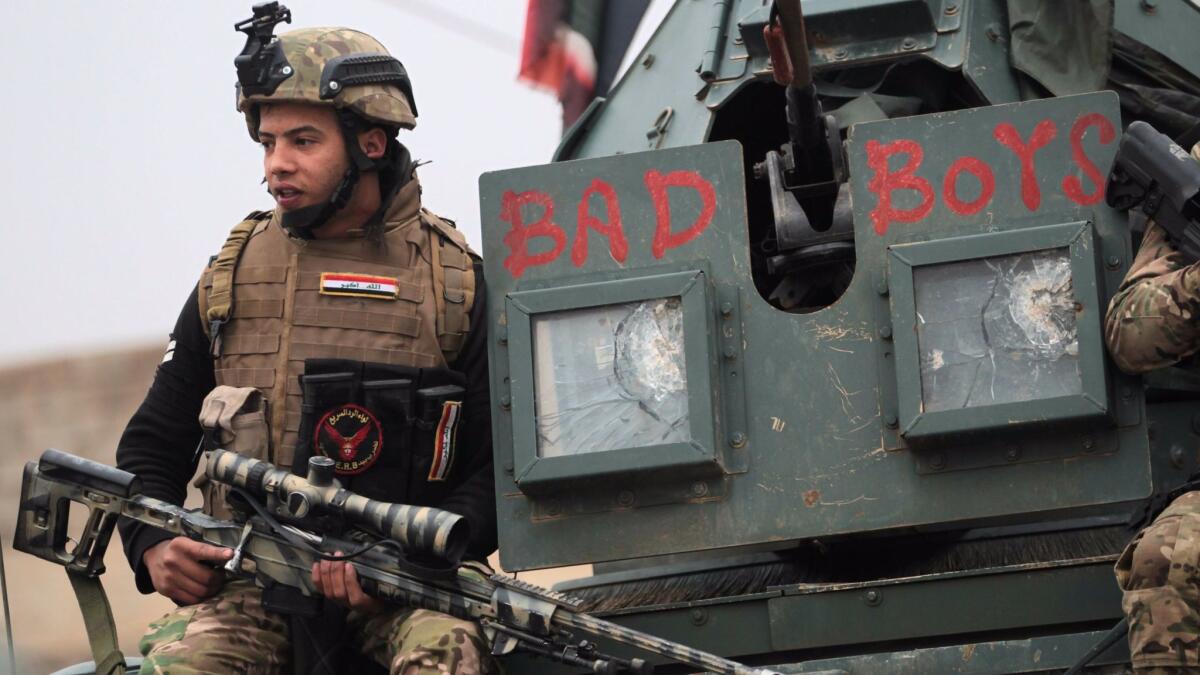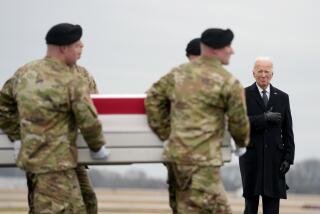New phase begins in offensive to drive Islamic State out of key city of Mosul

Reporting from Cairo ‚ÄĒ Iraqi security forces launched the second phase of their offensive against Islamic State in the key city of Mosul on Thursday, advancing into the city with U.S. forces embedded closer to the front line than in the past.
While Iraqi counter-terrorism and army units pushed forward from the north and east toward the Tigris River, which divides the city, several thousand federal police advanced to the southeast, commanders said.
‚ÄúThe prime minister gave us orders to reach the river in a short time. Now the second step, this morning, begins,‚ÄĚ Maj. Gen. Najim Jabouri, Iraqi army commander of the offensive, said by phone from a north Mosul neigbhorhood where he was overseeing troops.
Prime Minister Haider Abadi had hoped to retake Mosul by year’s end but said this week that he expected the offensive to take three more months.
Jabouri said troops started their latest attack at 7 a.m. with strong air support from U.S. forces, hoping to reach the river in a few days and to capture the city sooner than the prime minister expected.
To the north, units of the 16th Division of the Iraqi army cleared neighborhoods and took new ground. To the east, counter-terrorism troops pushed into the city along two fronts. To the south, federal police also began clearing Mosul neighborhoods.
‚ÄúThe Iraqi multi-axis advance opens two new fronts within the city and increases pressure on [Islamic State‚Äôs] dwindling ability to generate forces, move fighters or resupply,‚ÄĚ the U.S.-led coalition said in a statement.
Islamic State seized the northern city, Iraq’s second largest, two years ago, and it became central to the survival of the group’s self-proclaimed caliphate spanning Iraq and Syria.
The offensive to recapture Mosul began Oct. 17 as a joint effort by 100,000 Iraqi troops, Kurdish security forces and Shiite militiamen ‚ÄĒ all backed by the U.S.-led coalition ‚ÄĒ the country‚Äôs largest military operation since the U.S.-led invasion in 2003.
Earlier this week, the U.S.-led coalition laid the groundwork for the advance by bombing and disabling the last of five bridges spanning the Tigris. ‚ÄúThe strikes were conducted to reduce enemy freedom of movement and to further disrupt [Islamic State‚Äôs] ability to reinforce, resupply or use vehicle-borne improvised explosive devices in east Mosul,‚ÄĚ according to a coalition statement.
Since the start of the operation, the coalition has dropped more than 7,650 munitions in support of Iraqi forces.
Militants have been fighting bitterly to retain control of east Mosul, firing mortar shells into freed areas from nearby neighborhoods and sending in multiple suicide car bombs as well as drones armed with grenades, Jabouri said.
Even so, Jabouri said, Islamic State has weakened in recent weeks. ‚ÄúThey lose many casualties. They lose the ability to fight. Their morale is down,‚ÄĚ he said.
‚ÄúThe coalition forces, American forces, they did a good job. They destroyed eight [suicide car bombs] just here in the north route, and they destroyed three mortar crews and killed more than 40‚ÄĚ Islamic State fighters on Thursday, Jabouri said.
Yahia Rassol, an Iraqi military spokesman, noted the role the Tigris will play in the offensive against Islamic State.
‚ÄúThe enemy is currently isolated inside the left bank of Mosul,‚ÄĚ Rassol said on state television, referring to the west bank of the Tigris. ‚ÄúIn the coming days, Iraqi forces will liberate the entire left bank of Mosul, and after that we will tackle the right.‚ÄĚ
The advance into the city that began in October has been led by Iraqi counter-terrorism forces known as the Golden Division, which captured half the east side, then paused in recent weeks for what officials called an ‚Äúoperational refit‚ÄĚ after suffering heavy casualties.
As part of the refit, federal police and Interior Ministry rapid response units were sent in as reinforcements. Lt. Gen. Abdul-Wahab Saadi, commander of counter-terrorism forces in east Mosul, said they appreciated the help from federal police who ‚Äúhave experience with urban warfare.‚ÄĚ
U.S. military advisors have embedded closer to Iraqi forces in Mosul than previously. Jabouri said he was working with an American advisor near the front line Thursday.
‚ÄúHe helps me. He also watches the area. That‚Äôs very useful,‚ÄĚ Jabouri said.
About 114,000 of Mosul‚Äôs 1.2 million residents have fled the city, and fighting around those who have stayed has been a challenge for Iraqi troops, Jabouri said. U.S. technology ‚ÄĒ including precision rockets and airstrikes ‚ÄĒ has helped Iraqi forces target militants without harming civilians, he said.
‚ÄúWe depend on them in this battle,‚ÄĚ Jabouri said of U.S. air forces. ‚ÄúIn the city we cannot use our heavy weapons; it is very difficult. We need very high technology to fight [Islamic State] and not bother the people.‚ÄĚ
But a U.S.-coalition airstrike Thursday on a van of suspected Islamic State fighters may also have killed civilians.
Militants were seen firing rocket-propelled grenades, then loading the launcher in the van before the airstrike in what was later determined to be a hospital compound parking lot, according to a coalition statement. The coalition is investigating.
U.S. officials previously acknowledged that a coalition airstrike on Islamic State targets in the eastern Syrian province of Dair Alzour on Sept. 17 mistakenly hit Syrian government troops, killing 62.
Coalition officials have been investigating accusations by Syrian activists that airstrikes led to multiple deaths of civilians ‚ÄĒ eight people, including three children, in October north of Mosul and at least 20 more last month in a village near the Islamic State stronghold of Raqqah.
U.S. Central Command announced last month that during the last year, two dozen U.S. airstrikes in Iraq and Syria may have killed 64 civilians.
U.S. Army Col. Brett Sylvia said the coalition is ‚Äúdeepening its integration and now pushing that into more of the Iraqi formations,‚ÄĚ including federal police, providing advisors to the brigade level, as they have with the Iraqi army.
Greater integration with Iraqi forces puts U.S. troops ‚ÄĒ most of whom stay on or near their bases here ‚ÄĒ closer to the action than they have been since President Obama withdrew U.S. forces from Iraq in 2011. Four U.S. servicemen have been killed in northern Iraq since U.S. troops returned in 2014, mostly special forces deployed near the front line.
Navy Chief Petty Officer Jason Finan, 34, of Anaheim was attached to an elite SEAL team advising Iraqi counter-terrorism forces north of Mosul when his vehicle hit a roadside bomb and he was killed Oct. 20.
Navy SEAL Charles Keating IV was killed in a raid alongside Iraqi troops in May.
Marine Staff Sgt. Louis Cardin was killed by a rocket attack March 19 while he was stationed at an artillery outpost south of Mosul.
Army Master Sgt. Joshua Wheeler, a special forces commander, was killed during a raid on an Islamic State prison with Kurdish forces outside the northern city of Hawija in October 2015.
A coalition spokesman emphasized that U.S. troops embedding with Iraqi forces remained behind the front line.
‚ÄúAs has always been the policy, these advisors are not directly involved in combat but are prepared to defend themselves if necessary,‚ÄĚ said Army Col. Joe Scrocca, a coalition spokesman, adding that putting more coalition troops in the field will ‚Äúimprove synchronization of partner force units.‚ÄĚ
‚ÄúDaesh has proven vulnerable to decisive maneuver and simultaneous attacks along two or more axes,‚ÄĚ he said, using the Arabic acronym for Islamic State. He added that Islamic State forces ‚Äúare being bombarded daily by coalition air and artillery strikes, and they have no ability to reinforce or resupply.‚ÄĚ
Twitter: @mollyhf
ALSO
Turning Christmas season into an act of service to help wounded warriors at Camp Pendleton
The Iraqi government told Mosul residents to stay put. Now they are paying a heavy price
Americans adjust to a changed role in Iraq
UPDATES:
12:50 p.m.: This story was updated to report that an airstrike targeting Islamic State may have killed civilians.
This story was originally published at 7:15 a.m.
More to Read
Sign up for Essential California
The most important California stories and recommendations in your inbox every morning.
You may occasionally receive promotional content from the Los Angeles Times.










